
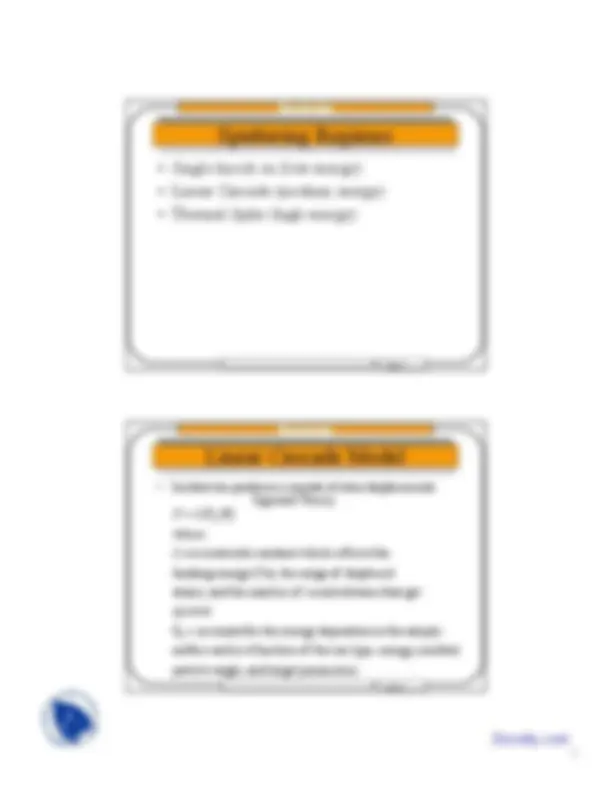
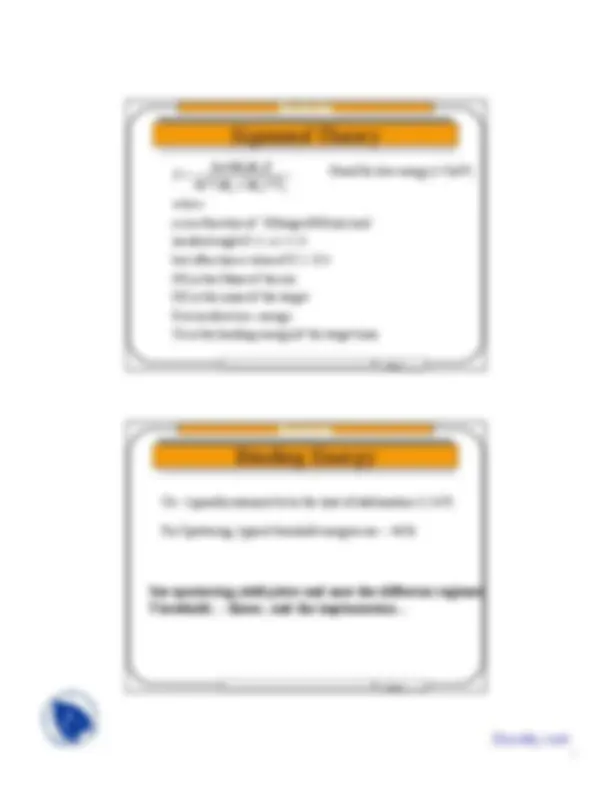
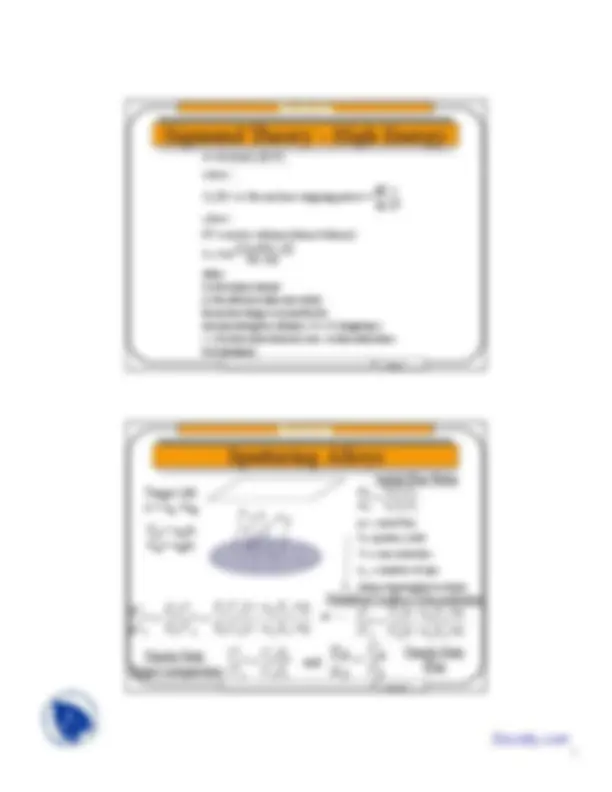
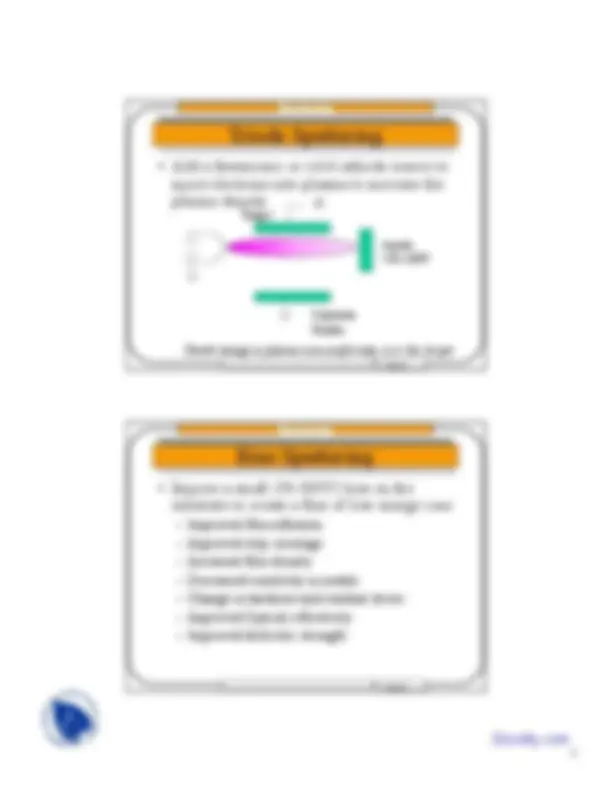
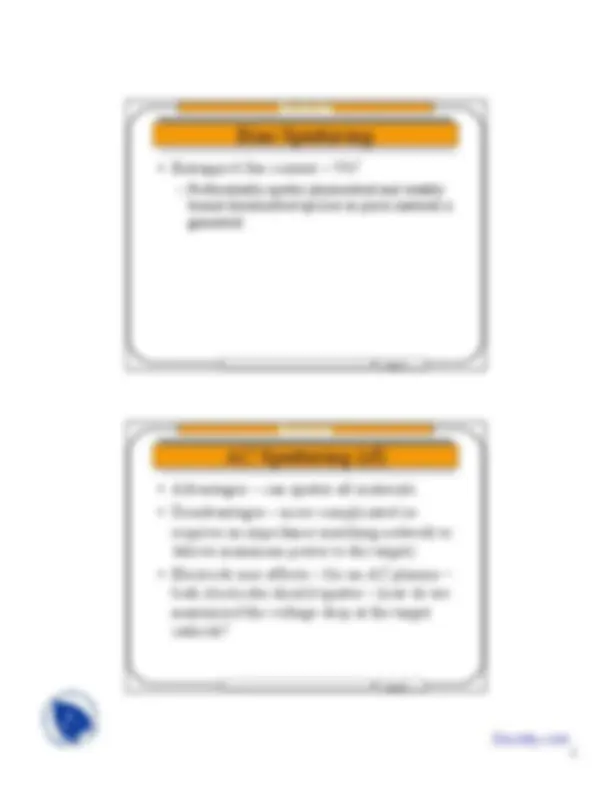
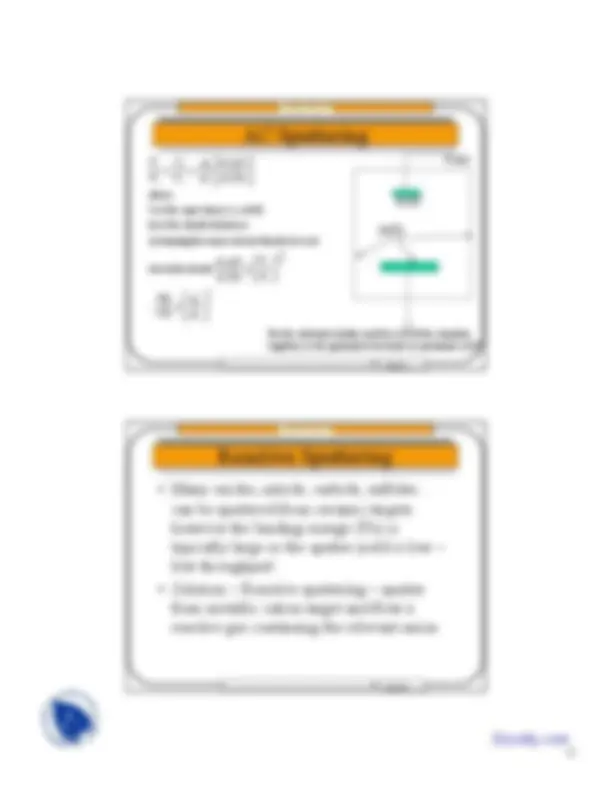


Study with the several resources on Docsity

Earn points by helping other students or get them with a premium plan


Prepare for your exams
Study with the several resources on Docsity

Earn points to download
Earn points by helping other students or get them with a premium plan
Community
Ask the community for help and clear up your study doubts
Discover the best universities in your country according to Docsity users
Free resources
Download our free guides on studying techniques, anxiety management strategies, and thesis advice from Docsity tutors
These are the Lecture Slides of Thin Film Materials Processing which includes Vaporization, Vapor Pressure Curves, Thermal Desorption, Molecular Binding Energy, First Order Desorption, Desorption Rate, Real Surfaces, Diffusion of Gas Particles etc. Key important points are: Sputtering, Ion-Solid Interactions, Ion-Solid Impact, Sputter Yield, Sputtering Regimes, Linear Cascade Model, Sigmund Theory, Binding Energy, Sputtering Alloys, Sputtering Energy Distribution
Typology: Slides
1 / 12

This page cannot be seen from the preview
Don't miss anything!







Page 1
Sputtering
Page 2
Page 3
Sputtering
Page 4
Page 7
Usisthebindingenergyofthetargetions
Eisincidention energy
M2isthemassofthetarget
M1istheMassoftheion
butoftenhasavalueof0.2-0.
incidentangle0.1 1.
isafunctionof M(target)/M(ion)and
2 1 2
2
1 2
α
α
π
α
where
S
Good for low energy (<1keV)
Sputtering
Page 8
Us – typcially assumed to be the heat of sublimation (2-5eV)
For Sputtering, typical threshold energies are ~ 4xUs
Page 9
volume(atoms/volume)
:
1 dz
( ) isthenuclearstoppingpower dE
:
N atomic
where
N
S E
where
S S E U
n
n S
=
= =
= α
been tabul ated)
'( )isthereducednuclearcross-section(whichhave
electronsduringthecollision(~0.1-0.2Angstroms)
thenuclearchargeisscreenedby the
aistheeffectiveradiusover which
Zistheatomicnumber
where:
4 '( ) 1 2
12 2 1
s E
M M S aZZqMs E
n
n n = π +
Sputtering
Page 10
Target AB n = nA +nB
CA = nA/n CB = nB/n
Initial Flux Ratio
atomsimpinging on target
n numberofgas
C concentration
S sputteryield
flux
g =
=
=
=
=
atom
nS C
nS C g B B
g A A B
A
ψ
ψ
ψ
Modified Surface Concentration
C n S n
C n S n C
B g B
A g A B
A −
B B g B
A A g A B B
A A B
A
Steady State Target composition (^) B A
A B B
A
B
A B
A
and
Steady State Flux
Page 13
Sputtering
Page 14
Eistheaveragesputteringenergy
eistheTownsendsecondaryelectroncoef.
istheatomicdensity
gisthecathode-anodegapdistance
atomstravelbeforetheybecomethermalized
xth isthemeandistancethesputtered
Pd dischargepowerdensity(W/cm2)
where
( 1 )
γ
ρ
ρ γ
< >
=
−
≈ < >
g E
P x s
G cm e
& d th
Page 15
Anode +50-100V
Target
Substrate Holder Disadvantage is plasma non-uniformity over the target
Sputtering
Page 16
Page 19
4
(^34)
( )
electrodesheath ( )
Assumingthesamecurrentdensityateach
dsisthesheath thickness
Cisthecapacitance( A/d)
where
( )
( )
∴ =
=
= =
rf
G
G
rf s
s
s
s rf
G rf
G G
rf
A
A VG
Vrf
V
V d G
d rf
d G
d rf A
A C
C V
V
ε
A(rf)
A(G)
Tie the substrate holder and the rest of the chamber together as the grounded electrode to maximize A(G)
V(ac)
Sputtering
Page 20
Page 21
Sputtering
Page 22
( )
formedbyonereactivegas molecule
aisthenumberofcompoundmolecules
qistheelectronchargeand
where
Φ r α t ( 1 −θ t ) Ata = j / q θ tAtSc
Target Steady State Compound Film Formation Rate
Total Target Erosion Rate
Substrate Mass Balance
Once iscalculatedfromabove canbe determined
therighthandtermisthemetalsputteredfromthetarget
2.isduetoreactionofthismetalwiththereactivegas
fromthetargetontothemetalfractionofthesubstrateand
rateonthesubstrate;1.duetosputterdepositionofthecompoundfrom
termsontheleftreflect thetwocontributionstocompoundformation
bisthenumberofmetalatomsinthecompound
where:
( / ) ( 1 ) ( 1 ) (/ ) ( 1 ) /
θt θs
j qSc θ (^) tAt −θ s +Φ r α s −θ sAsb = jq Sm −θ tAt θ sb